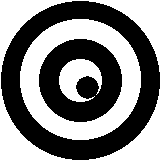The Hey may be defined as the rhythmical interlacing in serpentine fashion of two groups of dancers, moving in single file and in opposite directions.
The figure assumes different forms according to the disposition of the dancers. These varieties, however, fall naturally into two main types according as the track described by the dancers — disregarding the deviations made by them in passing one another — is (1) a straight line, or (2) the perimeter of a closed figure, circle or ellipse.
The second of these species, as the simpler of the two, will be first explained.
Figure 10.
THE CIRCULAR HEY
In the analysis that follows the circle will, for the sake of convenience, be used throughout to represent the track described by the dancers in this form of the figure. In the round dance the track will of course be a true circle; while in the square dance it will become one as soon as the movement has begun. On the other hand, in a longways dance, the formation will be elliptical rather than circular, but this will not affect the validity of the following explanation.
In the circular-hey the dancers, who must be even in number, are stationed at equal distances around the circumference of a circle, facing alternately in opposite directions, thus:-
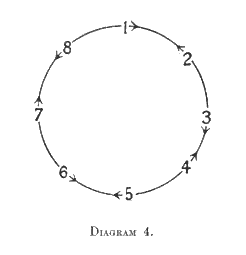
Odd numbers face and move round clockwise; even numbers counter-clockwise. All move at the same rate and upon meeting, pass alternately by the right and left.
The progression is shown in diagram 5, the dotted and unbroken lines indicating the tracks described respectively by odd and even numbers. It will be seen that in every circuit the two groups of dancers, odd and even, thread through each other twice; that is, there will be eight simultaneous passings, or changes, as we will call them, in each complete circuit:-
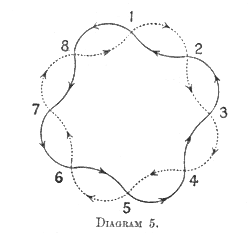
This movement is identical with that of the Grand Chain, except that in the familiar Lancers figure the performers take hands, alternately right and left, as they pass; whereas in the Country Dance hey, “handing,” as Playford calls it, is the exception rather than the rule.
In this form the hey presents no difficulty. No misconception can arise so long as (1) the initial disposition of the pairs, and (2) the duration of the movement, measured by circuits or changes, are clearly defined; and instructions on those two points will always be given in the notation. It should be understood that in the absence of directions to the contrary (1) the first pass is by the right, and (2) the dancers pass without handing.
Figure 11.
PROGRESSIVE CIRCULAR HEY
Sometimes the hey is danced progressively, the dancers beginning and ending the movement pair by pair, instead of simultaneously, as above described. This is effected in the following way:-
The first change is performed by one pair only, say Nos. 1 and 2 (see diagram 4, Fig.10); the second by two pairs, Nos. 1 and 3, and Nos. 2 and 8; the third in like manner by three pairs, and the fourth by four pairs. At the conclusion of the fourth change Nos. 1 and 2 will be face to face, each having traversed half a circuit, and all dancers will be actively engaged, thus:-
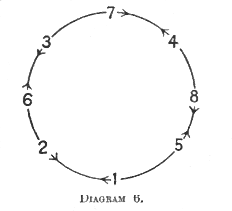
The movement now proceeds in the usual way. At the end of every complete circuit the position will be as follows:-
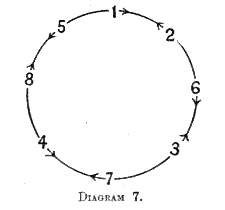
The figure is concluded in the following manner: Nos. 1 and 2, upon reaching their original places (see diagram 7), stop and remain neutral for the rest of the movement. The others continue dancing until they reach their proper places, when they, in like manner, stop and become neutral. This they will do pair by pair, in the following order, Nos. 3 and 8, 4 and 7, 5 and 6. The initial and final movements thus occupy the same time, i.e., four changes.
Whenever the progressive hey occurs (1) the initial pair will be named; and (2) the duration of the movement, measured by changes or circuits, will be given in the notation.
Figure 12.
THE STRAIGHT HEY
The dancers stand in a straight line at equidistant stations, alternately facing up and down, thus:-

Odd numbers face down; even numbers up. As in the circular hey the dancers move at an even rate, and pass each other alternately by the right and left. The movement is shown in diagram 9, the dotted and unbroken lines indicating, respectively, the upward and downward tracks described by the dancers:-

It will be seen that the dancers after making the last pass at either end make a whole-turn — bearing to the right if the last pass was by the right, or to the left if the last pass was by the left — and re-enter the line, now in reverse direction, the first pass after re-entrance being by the same shoulder, right or left, as the preceding one.
When the Straight-hey is performed by three dancers only, we have the form in which the hey occurs most frequently in the Country Dance. On this account it will perhaps be advisable to describe this particular case in detail.
THE STRAIGHT HEY-FOR THREE
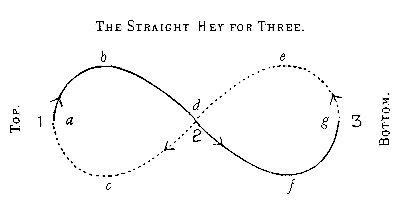
No.1 faces down, Nos. 2 and 3 up.
All simultaneously describe the figure eight, as shown in the above diagram, and return to places, passing along the unbroken line as they move down, and along the dotted line as they move up. At the beginning of the movement, therefore, No. 1 will dance along line a b, No. 2 along d c, and No. 3 along g e, i.e., Nos. 1 and 2 will pass by the right, Nos. 1 and 3 by the left.
In order that the dancers may not obstruct one another the two lobes of the figure should be made as broad as time and space will permit.
This is presumably the correct way in which the hey-for-three should be executed in the Country Dance, although we have no direct evidence that it was in fact so danced in Playford's day. Hogarth, however, in his Analysis of Beauty (1753), after defining the hey as "a cypher of S's, a number of serpentine lines interlacing and intervolving one another," prints a diagram of the hey-for-three which, although it might have been clearer, seems to show that the way the figure was danced at that period was substantially the same as that described above.
Moreover, Wilson (Analysis of Country Dancing, 1811) also describes the figure and prints a diagram, of which the following — except for clearness' sake the tracks are differentiated by means of varied lines — is a faithful reproduction:-

No. 1 moves along the broken line a; No. 2 along the line b; and No. 3 along the dotted line c.
Except that the two half-heys are inverted — the two lower dancers beginning the movement and passing by the left — the method shown in the diagram is precisely the same as we have above described.
The straight hey may be performed progressively. It is unnecessary, however to describe in detail the way in which this is effected, because, in principle, the method is the same as that already described in Fig.11.
Playford makes frequent use of the expressions “Single Hey” and “Double Hey”. It is difficult to say with certainty what he means by these terms, because he uses them very loosely. Very often they are identical with what we have called the straight- and circular-hey. As, however, this is not always the case, I have, with some reluctance, substituted the terms used above, which are self-explanatory and free from ambiguity.
Page transcribed by Hugh Stewart
